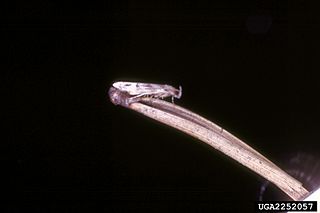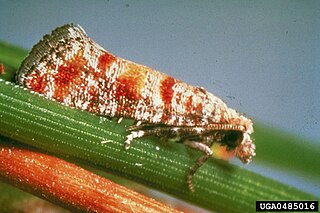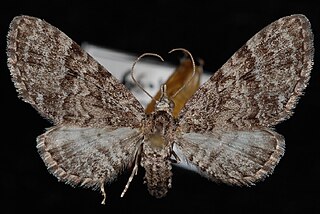
Pinus jeffreyi, also known as Jeffrey pine, Jeffrey's pine, yellow pine and black pine, is a North American pine tree. It is mainly found in California, but also in the westernmost part of Nevada, southwestern Oregon, and northern Baja California. It is named in honor of its botanist documenter John Jeffrey.

Pinus ponderosa, commonly known as the ponderosa pine, bull pine, blackjack pine, western yellow-pine, or filipinus pine is a very large pine tree species of variable habitat native to mountainous regions of western North America. It is the most widely distributed pine species in North America.

Plumas National Forest is a 1,146,000-acre (4,640 km2) United States National Forest located at the northern terminus of the Sierra Nevada, in northern California. The Forest was named after its primary watershed, the Rio de las Plumas, or Feather River.

Zelleria haimbachi, the pine needle sheathminer, is a moth of the family Yponomeutidae. In North America it is found from British Columbia south of 52° north latitude, east to Quebec and south to California.

Dasychira grisefacta, the pine tussock or grizzled tussock, is a moth of the family Erebidae. The species was first described by Harrison Gray Dyar Jr. in 1911. It is found in North America in Alberta, from British Columbia to Arizona and Oregon, in New Mexico, Montana, South Dakota and North Dakota.

Xestia praevia is a moth of the family Noctuidae. It is found in Canada south to California. It is part of the elimata species group. Three of the species in this group have no significant difference in both genitals and DNA, suggesting they may be in fact one species.

Choristoneura lambertiana, the sugar pine tortrix, is a moth of the family Tortricidae. It is found in the eastern parts of North America and the northern regions of the United States.

Protoboarmia porcelaria, the porcelain gray or dash-lined looper, is a Geometrid species of moth found throughout North America, except in the far north. The species was first described by Achille Guenée in 1857.

Rhyacionia frustrana, the Nantucket pine tip moth, is a moth of the family Tortricidae. It is found in the United States from Massachusetts south to Florida, west to Missouri, Oklahoma, Texas and California. It is also found in the Dominican Republic, Cuba, Jamaica, Mexico (Oaxaca), Guatemala, Honduras and Nicaragua.
Coleotechnites ponderosae, the ponderosa pine needleminer, is a moth of the family Gelechiidae. It is found in the United States, where it has been recorded from Colorado.

Rhyacionia bushnelli, the western pine tip moth, is a moth of the family Tortricidae. It is found in the United States, including Alabama, Nebraska, North Dakota and Montana.

Retinia albicapitana, the northern pitch twig moth, is a moth of the family Tortricidae. In Canada it is found from Nova Scotia to British Columbia and north probably into the southern parts of the Northwest Territories. In the United States, it extends as far south as Montana and the Great Lakes states.

Dioryctria auranticella, the ponderosa pineconeworm moth, is a moth of the family Pyralidae. The species was first described by Augustus Radcliffe Grote in 1883. It is found in western North America from southern British Columbia south to California and Arizona, east to South Dakota and New Mexico.

Eupithecia ornata is a moth in the family Geometridae. It is found from British Columbia and Alberta, south to California, Arizona and Nevada.
Eupinivora ponderosae is a species of moth of the family Tortricidae. It is found in the montane regions of the western United States from Nevada, Utah, Wyoming and Colorado, south to Arizona and New Mexico and east to Texas. The habitat consists of conifer-dominated areas at elevations ranging from 1,700 to 2,700 meters.

Argyrotaenia tabulana, the jack pine tube moth or lodgepole needletier moth, is a species of moth of the family Tortricidae. It is found in North America, where it has been recorded from Alabama, Arkansas, British Columbia, Florida, Georgia, Indiana, Louisiana, Maine, Maryland, Massachusetts, Mississippi, New Jersey, New York, North Carolina, Ohio, Oklahoma, Pennsylvania, South Carolina and West Virginia.
Chionodes sabinianus is a moth in the family Gelechiidae. It is found in North America, where it has been recorded from southern British Columbia to California.
Chionodes pinax is a moth in the family Gelechiidae. It is found in North America, where it has been recorded from southern British Columbia, Montana and Arizona.
Exoteleia anomala, the ponderoa pine needle miner, is a moth of the family Gelechiidae. It is found in the United States, where it has been recorded from Alabama, Louisiana, Mississippi, New Mexico and Arizona.
Coloradia doris or Doris' pinemoth, is a species of moth in the family Saturniidae, in the superfamily Bombycoidea. The species was described by William Barnes in 1900. It is found in North America. Larvae have been found on Pinus ponderosa and adults have been found on Pinus contorta and Pinus monophylla. Early instar larvae feed in groups, whereas late instar larvae are solitary feeders. The species overwinters as a pupa, with adults emerging in spring and summer.














